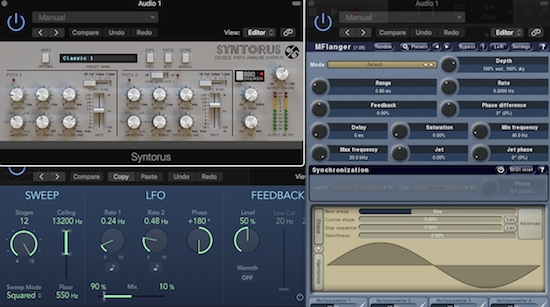
The notion of ‘width’ in the context of recorded sound has come a long way since Thomas Edison first unveiled his phonograph on an unsuspecting public.
Since then, we’ve moved from a ubiquity of monophonic playback systems to stereophony, giving mixing engineers and producers the option to artificially ‘place’ a given sound in the space between the listener’s left and right speaker.
Speed forward to today’s glut of hyper-charged, stadium-fuelled listening expectations and width, much like volume, has become a hunt for an ever more overblown peak.

To be clear, we at ModeAudio certainly don’t condone this quest for ever louder and wider tracks simply for their own sakes - if something is to be louder, or wider, then there should be a good reason for it!
When considered in a much subtler (and, arguably, more sensible) context however, width is absolutely something you can and should be playing around with in your music.
From spacing out those pads to achieve a deeper atmosphere, through to achieving supernaturally huge vocal effects, widening out your sound can be a valuable tool in the studio.
To this end, I’m proud to present to you 5 tips for expanding out the stereo field of your track - let’s dig in!
1. Double-Tracking
This age-old technique goes back to the foundations of studio recording, typically being applied to guitar and vocal parts to help beef them up in the mix.
A classic and very simple example would be for a vocal part to be double-tracked for the chorus section, wherein a second take is recorded and mixed with the original. As well as producing a more forceful and accentuated result, panning the two parts differently creates a sense of stereo width that would otherwise be entirely absent from a single, mono recording.
To double-track an instrumental audio part in your mix, simply record a second version and try panning the two parts hard left and hard right. This will create a really wide, expansive effect that sounds fantastic on guitars but might be a little disorientating for lead vocals.
Experimentation is key, as always!
For vocals, you could try having a main part panned centrally, then recording 2 additional versions that are panned left and right, as well as being mixed in a little lower than the main part. This will give you a strong lead vocal presence, plus contributing stereo width that might just be the lift your chorus needs.

2. Using Effects: Chorus, Phaser & Flanger
When dealing with loops or synths, you’ll need to be careful of phasing issues. As synths are ostensibly designed to give you more or less the same result every time you use a certain patch or preset, you have to avoid ‘beating’ that can occur when two very similar waveforms mix out of phase with each other, causing a loss in amplitude or volume.
You can mitigate this by giving the second synth version a different voicing, or changing some detail of the synth’s parameters, such as the waveforms used to generate the sound, or effects applied.
The two parts need to be different enough so that they don’t end up phasing with each other too much and causing unwanted dips in their combined amplitude, so if playing the two parts together sounds weird when compared to soloing the original, you’ll need to keep tweaking to get them to fit.
The same goes for loops - as you likely won’t have a variation of the audio file to hand, you can try applying effects to a copy of the original loop. Those which affect phase are particularly helpful here, such as a phaser, chorus or flanger, and tweaking the tuning just a tad will help also. Even just a few cents could do the trick!

3. Using Effects: Delay, Reverb & Pan Modulation
Sometimes, simply drawing the listener’s attention to the stereo space in your track can be enough to suggest a sense of width. The first thing that comes to mind here is, of course, reverb, the very point of which is to create an artificial sense of 3D space in your music!
A standard use of reverb is to setup a main reverb unit in a bus channel, and send varying amount of your track’s parts to the unit, so that they all sound like they’re situated in the same space. Sending more signal to the reverb unit will make that part feel like it’s further or deeper in the mix; less and the part will feel much closer to centre-stage.
You can of course get as creative with reverb as you like - try panning a really short impulse reverb bus hard left or right, and sending a part that is panned in the opposite direction to it. This of course will act quite like a slap-back delay but with the added impression of a physical room or space.

This leads me on nicely to the fact that a simple delay line can achieve something similar, though with a little less nuance and room for sculpting and modifying the effect. Put a delay on a bus, pan it right, and send -10dB of that left-panned guitar to it - instant width!
An auto-pan effect or anything that modulates the pan of your track for you can also be a useful tool here. Whilst much more drastic than the other options listed in this section, again simply drawing your listener’s attention to the stereo space of your track by moving a part back and forth between the speakers can work wonders in conjuring or maintaining a sense of horizontal distance in your mix.
A classic Rhodes piano or Wurlitzer sound is a great example of this - often made up of just a mono signal, with that classic, fast-moving auto-pan applied they suddenly take on a much larger sonic footprint!

4. Voice Stacking
Voice stacking is one of my favourite synth features, wherein multiple copies of a given waveform are mixed together and detuned slightly from one another to create a deliciously thick wedge of sound. It’s the secret ingredient that makes 80s analog synth pads sound so hypnotically huge!
If you’re using a soft synth and it has this feature then great, get experimenting. Otherwise, you can approximate it by using a decent chorus plugin, which employ delay lines to basically achieve the same effect.
You could even stack your chorus effects - apply a chorus effect directly on the track you want to add width to, but dial the mix control down so the chorus part of the chain is fairly quiet. Then, send some of this track to a bus with another chorus effect applied albeit using different settings.
By careful tweaking of the settings and mix levels, as well as even panning the bus track away from the source signal, you can achieve a nice, phat sound that’s really quite CPU-friendly!

5. Using Effects: Stereo Imaging
My final tip is probably the most obvious - use a stereo widening or imaging plugin. However, the fact that these plugins have improved in leaps and bounds in recent years and are available in the form of a number of excellent free versions (check out iZotope's for an example), certainly means they warrant a mention here!
Often, stereo imagers allow you to change the perceived stereo width of your track per frequency band, giving you a large degree of control over the sense of space in your music.
This is especially helpful on your master bus, where you can add a little extra width to the highs in your mix, whilst reining in the lows.
However, they can also be handy when used further back in your mix - that pad part not quite feeling as high and wide as you’d like? Throw an imager on there and push the treble as far as it will go!
These plugins aren’t get-out-of-jail free cards or anything, but they can certainly help to add an amount of usually subtle, realistic width to your parts.
The Take-Away
Most of my suggestions above can be used to varying degrees of extremity and as ever, I would urge you to apply them with cautious at first, at least till you get the hang of how they can be used in conjunction with your own production style.
The important point however is that you shouldn't just settle for the width inherent in a given sound, whether that's a stereo soft synth patch, loop or your own multi-mic recordings - give the tips above a spin and see of you can't expand out your horizons a least a little bit!













